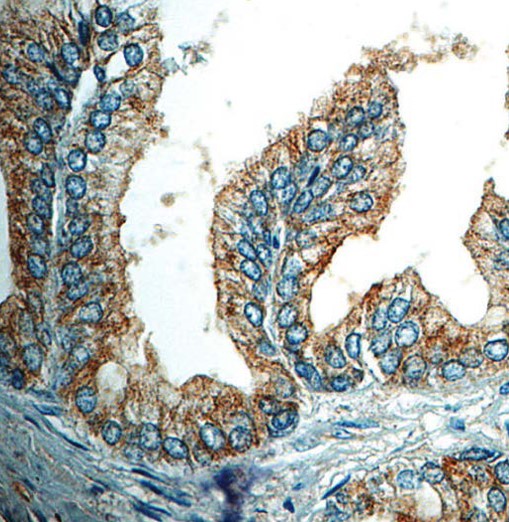Anti-Nerve Growth Factor Receptor (NGFR) Antibody (34064)
$284.00
Overview
Product Name Anti-Nerve Growth Factor Receptor (NGFR) Antibody (34064)
Description Anti-Nerve Growth Factor Receptor (NGFR) Mouse Monoclonal Antibody
Target Nerve Growth Factor Receptor (NGFR)
Species Reactivity Human
Applications IHC
Host Mouse
Clonality Monoclonal
Clone ID G637.1
Isotype IgG1
Immunogen Recombinant human NGFR.
Properties
Form Liquid
Concentration Lot Specific
Formulation Tris buffer, pH 7.3-7.7, 1% BSA, 0.1% sodium azide.
Buffer Formulation Tris
Buffer pH pH 7.3-7.7
Buffer Anti-Microbial 0.1% Sodium Azide
Buffer Protein Stabilizer 1% Bovine Serum Albumin
Format Purified
Purification Purified by immunoaffinity chromatography
Specificity Information
Specificity Human NGFR. Reactivity with other species has not been investigated.
Target Name Tumor necrosis factor receptor superfamily member 16
Target ID Nerve Growth Factor Receptor (NGFR)
Uniprot ID P08138
Alternative Names Gp80-LNGFR, Low affinity neurotrophin receptor p75NTR, Low-affinity nerve growth factor receptor, NGF receptor, p75 ICD, CD antigen CD271
Gene Name NGFR
Sequence Location Cell membrane, Perikaryon, Cell projection, growth cone, Cell projection, dendritic spine
Biological Function Low affinity receptor which can bind to NGF, BDNF, NTF3, and NTF4. Forms a heterodimeric receptor with SORCS2 that binds the precursor forms of NGF, BDNF and NTF3 with high affinity, and has much lower affinity for mature NGF and BDNF (PubMed:24908487). Plays an important role in differentiation and survival of specific neuronal populations during development (By similarity). Can mediate cell survival as well as cell death of neural cells. Plays a role in the inactivation of RHOA (PubMed:26646181). Plays a role in the regulation of the translocation of GLUT4 to the cell surface in adipocytes and skeletal muscle cells in response to insulin, probably by regulating RAB31 activity, and thereby contributes to the regulation of insulin-dependent glucose uptake (By similarity). Necessary for the circadian oscillation of the clock genes ARNTL/BMAL1, PER1, PER2 and NR1D1 in the suprachiasmatic nucleus (SCmgetaN) of the brain and in liver and of the genes involved in glucose and lipid metabolism in the liver (PubMed:23785138). {UniProtKB:Q9Z0W1, PubMed:14966521, PubMed:23785138, PubMed:24908487, PubMed:26646181, PubMed:3022937}.
Research Areas Cancer research
Background Nerve Growth Factor Receptor (NGFR), also known as p75, P-75NTR or CD271, is a neurotrophin receptor belonging to the tumor necrosis factor receptor family. NGFR is expressed on Schwann cells and neurons as well as a number of other non-neuronal cell types, and it functions during central and peripheral nervous system development to regulate neuronal growth, migration, differentiation, and cell death. Nerve Growth Factor Receptor is also expressed on melanocytes, melanomas, neuroblastomas, pheochromocytomas, neurobromas, neurotized nevi (type C melanocytes), and other neural crest cell or tumor derivatives.
Application Images


Description Immunohistochemistry: use at a dilution of 1:100-1:200 on formalin-fixed, paraffin-embedded samples after heat-induced epitope retrieval at pH 9 for 10-30 minutes. Detection of NGFR in human prostate with #34064 diluted 1:100-1:200.
Handling
Storage Store at 2-8°C. Do not freeze.
Dilution Instructions Dilute in PBS or medium that is identical to that used in the assay system.
Application Instructions
Immunohistochemistry: use at a dilution of 1:100-1:200 on formalin-fixed, paraffin-embedded samples after heat-induced epitope retrieval at pH 9 for 10-30 minutes.
Immunohistochemistry: use at a dilution of 1:100-1:200 on formalin-fixed, paraffin-embedded samples after heat-induced epitope retrieval at pH 9 for 10-30 minutes.
References & Data Sheet
Data Sheet  Download PDF Data Sheet
Download PDF Data Sheet
 Download PDF Data Sheet
Download PDF Data Sheet


